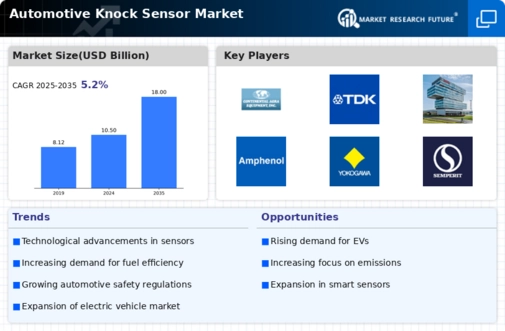Market Growth Projections
The Global Automotive Knock Sensor Market Industry is poised for substantial growth, with projections indicating a market value of 10.5 USD Billion in 2024 and an anticipated increase to 18.0 USD Billion by 2035. This growth trajectory suggests a compound annual growth rate of 5.04% from 2025 to 2035. Such projections reflect the increasing integration of knock sensors in modern vehicles, driven by advancements in technology and rising consumer demand for efficient and environmentally friendly automotive solutions. The market's expansion is indicative of broader trends within the automotive industry, where performance optimization and regulatory compliance are becoming paramount.
Stringent Emission Regulations
The Global Automotive Knock Sensor Market Industry is significantly driven by stringent emission regulations imposed by governments worldwide. These regulations compel manufacturers to adopt technologies that reduce harmful emissions from vehicles. Knock sensors are integral to this effort, as they optimize engine performance and minimize the release of pollutants. Compliance with these regulations is not merely a legal obligation but also a competitive advantage in the market. As the automotive sector adapts to these evolving standards, the demand for knock sensors is likely to increase, contributing to a projected compound annual growth rate of 5.04% from 2025 to 2035.
Consumer Awareness and Preferences
Consumer awareness regarding vehicle performance and maintenance is driving the Global Automotive Knock Sensor Market Industry. As consumers become more informed about the benefits of advanced automotive technologies, they increasingly seek vehicles equipped with features that enhance performance and longevity. Knock sensors, which contribute to smoother engine operation and improved fuel efficiency, are becoming a focal point in consumer decision-making. This trend is likely to bolster market growth as manufacturers respond to consumer preferences by integrating advanced knock sensor technologies into their vehicles, thereby enhancing overall vehicle appeal and competitiveness.
Increasing Demand for Fuel Efficiency
The Global Automotive Knock Sensor Market Industry is experiencing a surge in demand for fuel-efficient vehicles. As consumers become more environmentally conscious, automakers are compelled to enhance engine performance while minimizing fuel consumption. Knock sensors play a crucial role in optimizing combustion, which directly impacts fuel efficiency. This trend is evident as the market is projected to reach 10.5 USD Billion in 2024, reflecting a growing emphasis on sustainable automotive technologies. The integration of advanced knock sensors in vehicles not only improves fuel economy but also reduces harmful emissions, aligning with global regulatory standards aimed at promoting cleaner transportation.
Growth of Electric and Hybrid Vehicles
The rise of electric and hybrid vehicles is reshaping the Global Automotive Knock Sensor Market Industry. Although traditional combustion engines have been the primary focus for knock sensors, the increasing adoption of hybrid technologies necessitates the integration of advanced engine management systems. These systems often incorporate knock sensors to enhance performance and efficiency. As the market for electric and hybrid vehicles expands, the demand for sophisticated engine control technologies, including knock sensors, is expected to grow. This shift indicates a broader trend towards electrification in the automotive sector, which may further influence market dynamics in the coming years.
Technological Advancements in Sensor Technology
Technological advancements are significantly influencing the Global Automotive Knock Sensor Market Industry. Innovations in sensor technology, such as the development of piezoelectric and MEMS-based knock sensors, enhance the accuracy and responsiveness of these devices. These advancements enable real-time monitoring of engine conditions, allowing for better performance tuning and increased reliability. As a result, the market is expected to grow, with projections indicating a rise to 18.0 USD Billion by 2035. The continuous evolution of sensor technology not only improves engine efficiency but also supports the automotive industry's transition towards more sophisticated and intelligent vehicle systems.























